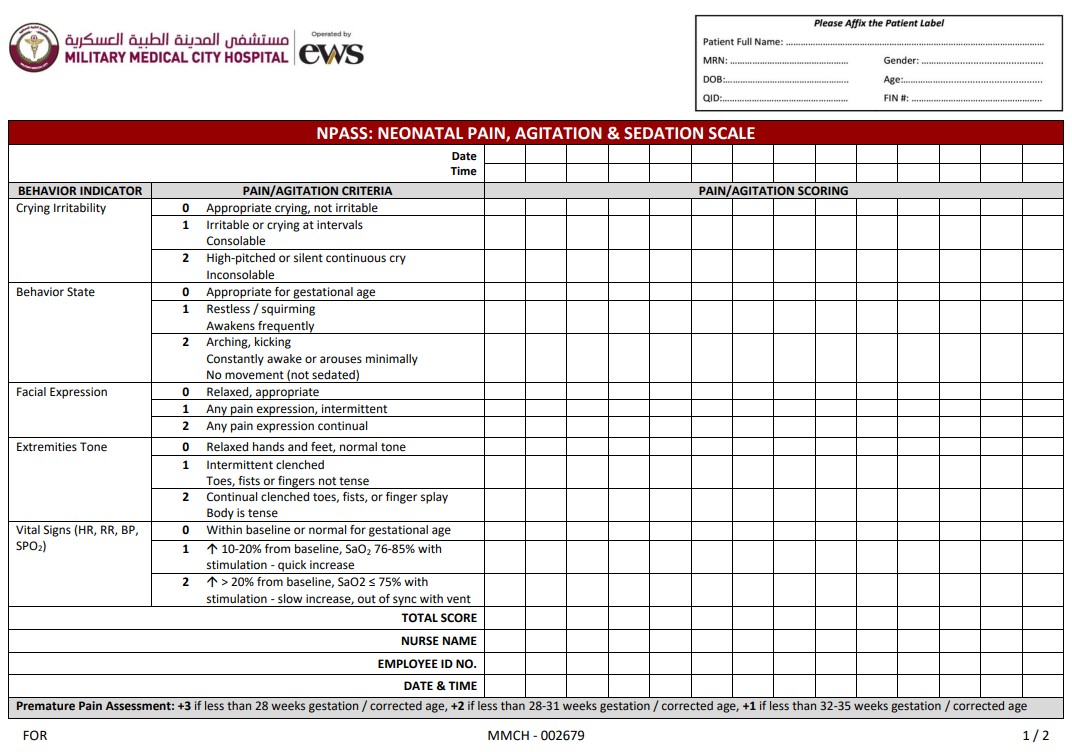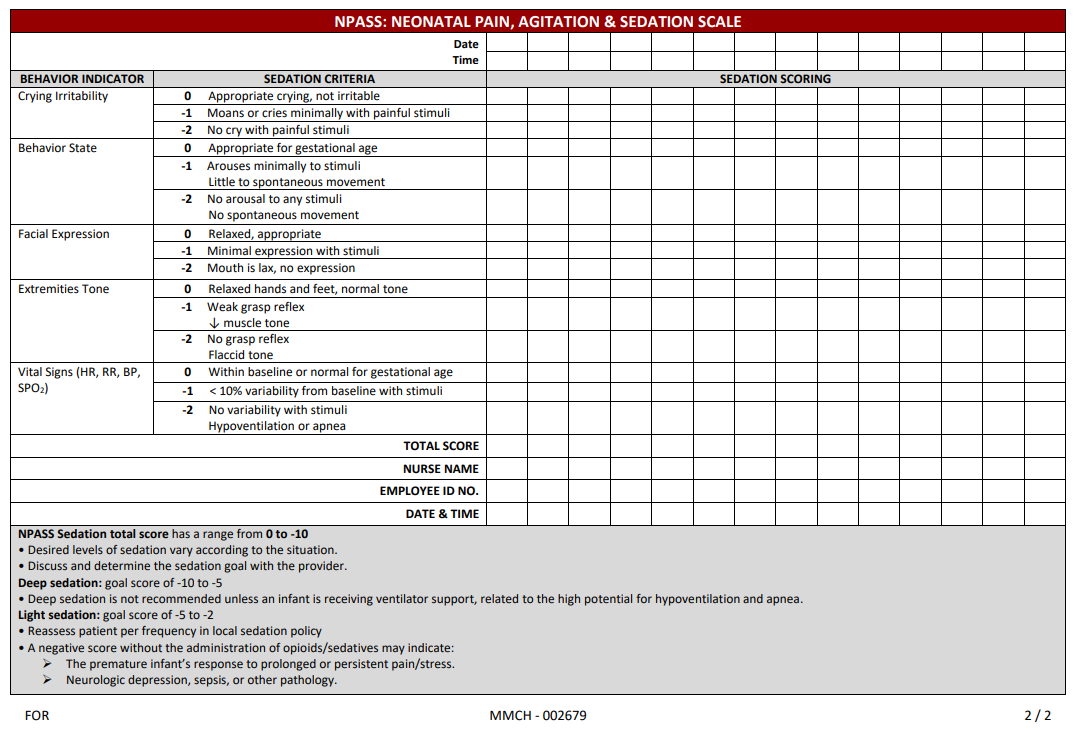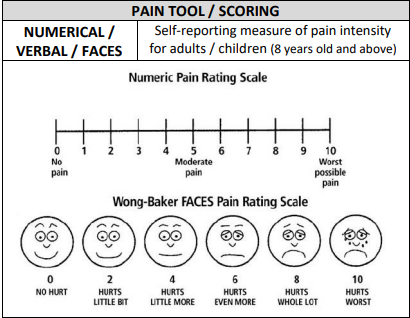Assessment of Pain in Children
Assessing pain in children requires age-appropriate and reliable tools, especially when children are unable to verbalize their discomfort. The tools you mentioned—R-FLACC, NPASS, NIPS, PIPS, and Wong-Baker—are commonly used for pain assessment across various pediatric age groups. Here’s an overview of each tool and how it helps assess pain in children:
1. R-FLACC Scale (Revised FLACC Scale)
The R-FLACC scale is a revised version of the FLACC scale, used to assess pain in infants and young children who cannot verbally communicate. The tool is based on five categories: Facial Expression, Leg Movement, Activity, Cry, and Consolability. Each category is scored from 0 to 2, and the total score ranges from 0 to 10, with higher scores indicating more intense pain.
Facial Expression: Is the child’s face relaxed or grimacing?
Leg Movement: Are the child’s legs relaxed, tense, or restless?
Activity: Is the child relaxed, squirming, or rigid?
Cry: How intense or frequent is the crying?
Consolability: How easily can the child be comforted?
Scoring:
0: No pain or discomfort
1: Mild pain or discomfort
2: Severe pain or discomfort
Use: Suitable for infants and young children (typically under 3 years of age) who cannot self-report pain.

2. NPASS (Neonatal Pain, Agitation, and Sedation Scale)
The NPASS is used primarily for neonates (newborns) in assessing pain, agitation, and sedation. It evaluates five indicators:
Cry: Intensity of crying (absent, mild, moderate, high-pitched)
Facial Expression: Relaxed, grimacing, or frowning
Extremities: Movement or tension in arms and legs
Tone: Muscle tone (relaxed, tense, or rigid)
Consolability: The ability to comfort the infant
Each of these indicators is scored from 0 to 2, and the total score ranges from 0 to 10. A higher score indicates greater pain or distress.
Scoring:
0: No pain or agitation
1–2: Mild to moderate pain or agitation
3–4: Moderate to severe pain or agitation
Use: Best for neonates and young infants (usually in NICUs or post-surgical recovery in neonates).


3. NIPS (Neonatal Infant Pain Scale)
The NIPS is another tool used for neonates and infants (from birth to 1 year old). It evaluates six behaviors associated with pain:
Facial Expression: Grimacing or a relaxed face
Cry: Intensity and quality of cry
Breathing Patterns: Changes in breathing or irregularities
Arms and Legs: Tension or relaxed limbs
State of Arousal: Alertness or restlessness
Body Movement: Movements indicative of pain or discomfort
Each item is scored from 0 to 2, and the total score ranges from 0 to 10. A higher score indicates greater pain.
Scoring:
0: No pain
1–3: Mild pain
4–6: Moderate pain
7–10: Severe pain
Use: Ideal for neonates and infants (up to 1 year) to assess acute pain, especially in response to procedures or after surgery.

4. PIPS (Premature Infant Pain Profile)
The PIPS scale is specifically designed to assess pain in preterm infants in the neonatal intensive care unit (NICU) setting. It evaluates seven indicators of pain, which include both physiological and behavioral responses:
Facial Expression
Body Movement
Muscle Tone
Cry
Heart Rate: Elevated heart rate as a sign of distress
Oxygen Saturation: Decreased oxygen levels during pain episodes
Respiratory Rate: Changes in breathing as a response to pain
Each indicator is scored from 0 to 3, with the total score ranging from 0 to 21. A higher score indicates greater pain severity.
Scoring:
0–5: Mild pain
6–10: Moderate pain
11–21: Severe pain
Use: Primarily for preterm infants in NICU settings to assess pain and distress levels during procedures or treatments.
5. Wong-Baker FACES Pain Rating Scale
The Wong-Baker FACES Pain Rating Scale is one of the most widely used pain assessment tools for children aged 3 years and older. This tool uses a series of six faces, ranging from a happy face (representing no pain) to a crying face (representing severe pain). Children are asked to select the face that best matches how they feel.
The faces represent increasing levels of pain intensity, with 0 representing “no pain” and 10 representing “worst pain ever.”
The scale is visual and straightforward, making it easy for children to understand and use.
Scoring:
The child selects a face between 0 (no pain) and 10 (worst pain) to report their pain level.
Use: Effective for children aged 3 years and older who can understand and express their feelings about pain using facial expressions.

ConclusionSelecting the right tool for assessing pain in children depends on the child's age, developmental level, and ability to communicate. Tools like R-FLACC, NPASS, NIPS, and PIPS are useful for infants and neonates who cannot verbalize pain, focusing on observable behaviors and physiological signs. The Wong-Baker FACES scale is effective for children 3 years and older, relying on self-reported pain using facial expressions.
In pediatric pain management, it’s essential to assess pain regularly, adapt pain management strategies accordingly, and consider both physiological and behavioral indicators to ensure comprehensive and effective care for the child.